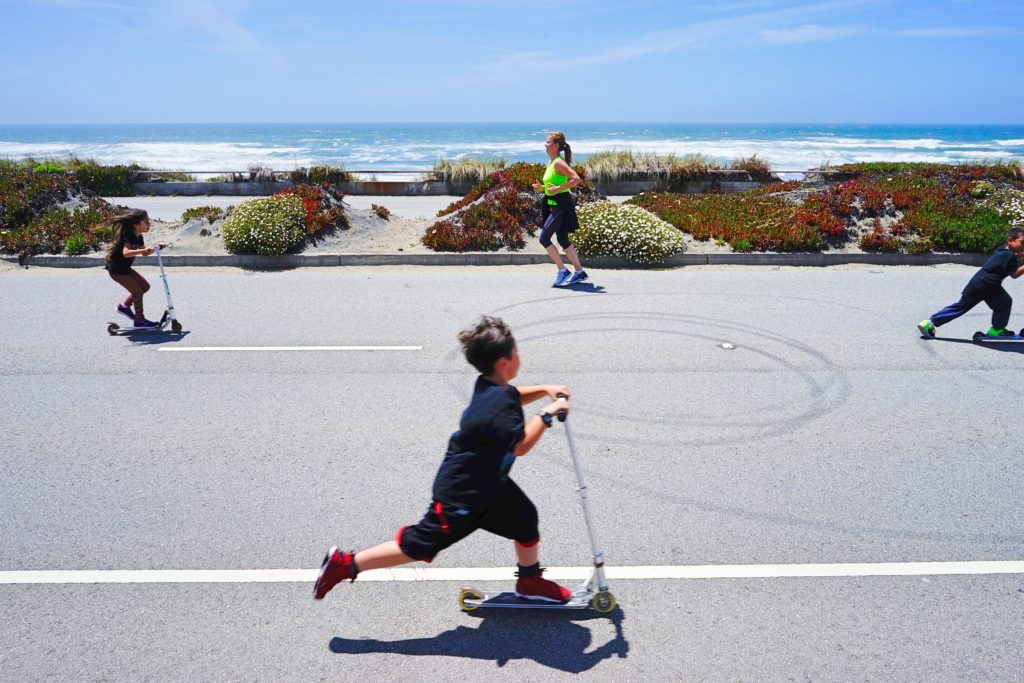Why One Mile? The Case for Open Streets

By Marynoel Strope
“Why is Sunday Streets so spread out?”
“Why not have it all one one block? It would be so much busier!”
“Sunday Streets should sell alcohol to bring more people in!”
While Sunday Streets San Francisco’s Activity Hubs can feel like a street fair, there’s a big difference: Sunday Streets is an open streets program, with routes one to four miles in length and a mission to reimagine our streets as public spaces for public health and social connection.
Through its roots with the Shape Up SF Coalition, Sunday Streets was founded on the principles of HEAL (Healthy Eating, Active Living) Campaign, harnessing the power of local governments to advance health equity and address health disparities. HEAL legislation mandates everything from healthy food options in public meetings to PE time for youth in public schools.
“Cities, communities and neighborhoods can be places where physical, social and economic conditions make health a reality for all,” according to HEAL. And that’s just what open streets do – use existing city infrastructure to create safe space for recreation.
This focus on health guides Sunday Streets. Unlike most festivals, Sunday Streets doesn’t serve or sell alcohol and the event’s sampling guidelines ensure the day isn’t full of junk food and sugar-sweetened beverages. In accordance with HEAL, encouraging active living and healthy eating is a core part of the Sunday Streets mission.
These policies affect the way the Sunday Streets team works, too – the office even has a health captain who helps maintain the Livable City office for health and wellness.
Open Streets Vs. Street Fairs
Most people are used to street fairs and festivals, which tend to pack a lot of programming into a few blocks. Open streets programs do what many street fairs do not: provide enough open space for attendees to complete their weekly exercise, just by walking (or rolling) from one Activity Hub to another. International standards recommend routes of three to 10 miles in length for this very reason – while block-long events are fun and worthwhile, they just don’t provide the public health benefits of an open street program.
Sunday Streets transforms car-clogged city streets into safe, temporary parks and prioritizes neighborhoods (like the Tenderloin) who lack access to open space and recreation. These lower-income neighborhoods suffer from extreme health disparities as compared to wealthier, less racially diverse areas.
The Case for Streets as Parks
There are other types of temporary parks, such as the parklets that pop up in the parking lane, providing seating, greenery and space for social connection. While an asset to city streets, their small footprints do not provide enough space for active recreation, and their proximity to cars make them less safe than an enclosed park.
Safety is a key component to creating a successful space for both active (biking, jogging, hula-hooping) and passive (card games, socializing and art projects) recreation – and open streets programs provide a sense of safety that city residents cannot get while dodging cars on a city street on a regular day. The sense of safety means people stick around longer, and feel comfortable moving about without risk of injury.
And providing this fun, safe space has another health benefit – one you can get even if you’re not exercising.
A Space for People of All Ages and Abilities
Studies have shown social connection has positive mental and physical health benefits. Open streets programs that create common areas help ease loneliness, as well as provide a low-barrier way for those with limited mobility to participate and enjoy the day. The simple act of going outside and seeing your neighbors can improve mental and physical health.
In an increasingly competitive San Francisco – where we all must compete for jobs, seats on the bus or at a cafe, on our sidewalks as pedestrians, and especially for housing (indeed, for space itself), open streets programs create a non-competitive environment. They show that there is enough space for everyone if we reimagine our streets as public spaces.
Room to Dream Big and Heal through Imagination
Long routes also provide endless space for programming and fun activities that draw people in so they can reap the benefits of open streets. Sunday Streets’ collaborative model and mile-plus length allows for residents, small businesses and local organizations – the stakeholders who know the neighborhood best – to dream big and bring important cultural events and celebrations to the day.
This process encourages capacity-building, especially in underserved communities, supporting creativity and imagination as community members bring their ideas to life and out into the streets.
From entire orchestra performances to collaborative mural painting to low-rider bike shows, the long footprint of the events means that there is always room to plan something big – and that activity just may take place right outside your front door.
